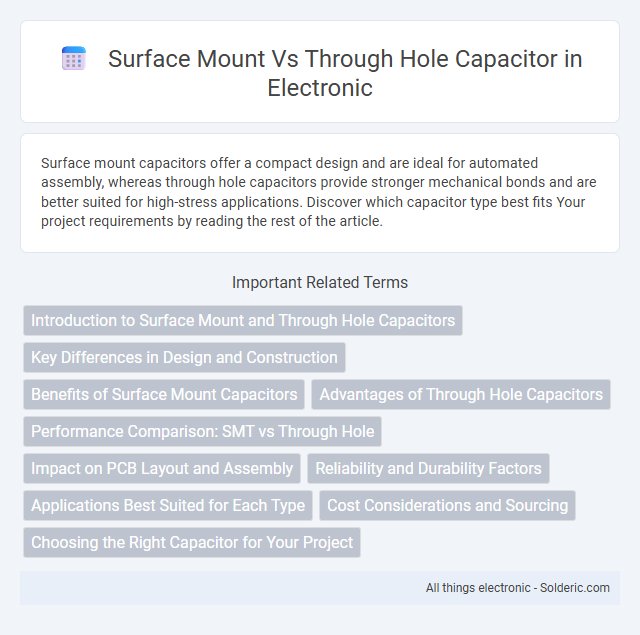Surface mount capacitors offer a compact design and are ideal for automated assembly, whereas through hole capacitors provide stronger mechanical bonds and are better suited for high-stress applications. Discover which capacitor type best fits Your project requirements by reading the rest of the article.
Comparison Table
| Feature | Surface Mount Capacitor | Through Hole Capacitor |
|---|---|---|
| Mounting Type | Soldered directly onto PCB pads | Leads inserted through PCB holes and soldered |
| Size | Smaller, compact dimensions | Larger, bulkier components |
| Assembly | Automated pick-and-place compatible | Manual or automated insertion required |
| Mechanical Strength | Lower, sensitive to mechanical stress | Higher, strong lead anchoring |
| Frequency Performance | Better high-frequency response | Less effective at high frequencies |
| Cost | Generally lower manufacturing cost | Higher cost due to labor and materials |
| Applications | Modern electronics, high-density PCBs | Power supplies, high-reliability circuits |
| Repairability | More difficult to replace manually | Easier manual replacement and prototyping |
Introduction to Surface Mount and Through Hole Capacitors
Surface mount capacitors are small, lightweight components designed for automated assembly on printed circuit boards (PCBs), offering higher density and better performance at high frequencies. Through hole capacitors feature leads that pass through PCB holes, providing stronger mechanical bonds ideal for high-stress or high-reliability applications. Understanding the differences between surface mount and through hole capacitors helps optimize your PCB design for size, performance, and assembly methods.
Key Differences in Design and Construction
Surface mount capacitors (SMCs) are designed with compact, flat rectangular bodies and metal terminations on both ends, enabling direct soldering onto the PCB surface for efficient space utilization and automated assembly. Through hole capacitors feature wire leads that pass through drilled holes in the PCB, offering stronger mechanical bonds suitable for high-stress environments and easier prototyping or manual assembly. Your choice between these capacitor types depends on the PCB design constraints, assembly processes, and mechanical durability requirements, with SMCs favored for miniaturized, high-volume production, and through hole capacitors preferred for robust or legacy applications.
Benefits of Surface Mount Capacitors
Surface mount capacitors offer significant benefits including smaller size, which enables higher circuit density and more compact electronic devices. Their automated placement enhances manufacturing efficiency and reduces production costs compared to through hole capacitors. These capacitors also provide better high-frequency performance due to lower parasitic inductance and capacitance, making them ideal for modern electronic applications.
Advantages of Through Hole Capacitors
Through hole capacitors offer superior mechanical strength and are ideal for applications requiring high reliability, such as automotive and aerospace electronics. Their larger size allows for higher capacitance values and voltage ratings compared to surface mount capacitors. You can also benefit from easier prototyping and manual soldering with through hole components, making them suitable for testing and repairs.
Performance Comparison: SMT vs Through Hole
Surface mount capacitors (SMT) offer superior high-frequency performance and lower parasitic inductance compared to through-hole capacitors, making them ideal for compact, high-speed electronic circuits. Through-hole capacitors provide better mechanical strength and are preferred in applications requiring higher power handling or durability under stress. Your choice between SMT and through-hole capacitors should consider the specific performance requirements, including size constraints, frequency response, and environmental conditions.
Impact on PCB Layout and Assembly
Surface mount capacitors significantly reduce PCB space and enable higher component density, facilitating automated pick-and-place assembly for faster production times. Through-hole capacitors require larger drill holes and more PCB real estate, making layouts more complex and assembly slower due to manual insertion or wave soldering processes. Your choice impacts manufacturing efficiency, with surface mount technology favoring compact, high-speed assembly and through-hole providing stronger mechanical connections for demanding applications.
Reliability and Durability Factors
Surface mount capacitors offer higher reliability in automated assembly due to consistent solder joints and reduced mechanical stress, enhancing overall durability in compact electronic devices. Through hole capacitors provide greater mechanical strength and are less prone to physical damage from vibration or thermal cycling, making them suitable for high-stress environments. Your choice depends on the specific application's demands for durability and reliability under operational conditions.
Applications Best Suited for Each Type
Surface mount capacitors excel in compact, high-density circuit boards for consumer electronics, smartphones, and laptops due to their small size and automated assembly compatibility. Through hole capacitors are best suited for applications requiring high reliability and mechanical strength, such as power supplies, industrial equipment, and automotive electronics. Your choice depends on the specific application requirements, including space constraints, durability, and manufacturing processes.
Cost Considerations and Sourcing
Surface mount capacitors typically offer lower production costs due to automated assembly processes and smaller package sizes, making them ideal for high-volume manufacturing. Through hole capacitors may incur higher costs related to manual labor and longer assembly times, but they provide stronger mechanical bonds suitable for robust, high-reliability applications. When sourcing components, surface mount capacitors benefit from widespread availability and a broad range of values, while through hole capacitors might require specialized suppliers depending on the specific requirements of Your project.
Choosing the Right Capacitor for Your Project
Selecting the right capacitor involves evaluating surface mount (SMT) and through-hole types based on size constraints, performance requirements, and assembly methods. Surface mount capacitors offer compact design and automated PCB assembly suitability, ideal for high-density circuits and modern electronics. Through-hole capacitors provide stronger mechanical bonds, better suited for high-stress environments and prototyping where manual soldering is preferred.
Surface mount vs through hole capacitor Infographic

 solderic.com
solderic.com